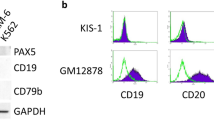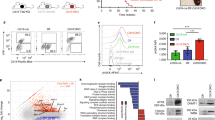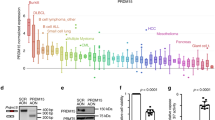Abstract
Developing pre-B cells in the bone marrow alternate between proliferation and differentiation phases. We found that protein arginine methyl transferase 1 (PRMT1) and B cell translocation gene 2 (BTG2) are critical components of the pre-B cell differentiation program. The BTG2-PRMT1 module induced a cell-cycle arrest of pre-B cells that was accompanied by re-expression of Rag1 and Rag2 and the onset of immunoglobulin light chain gene rearrangements. We found that PRMT1 methylated cyclin-dependent kinase 4 (CDK4), thereby preventing the formation of a CDK4-Cyclin-D3 complex and cell cycle progression. Moreover, BTG2 in concert with PRMT1 efficiently blocked the proliferation of BCR-ABL1-transformed pre-B cells in vitro and in vivo. Our results identify a key molecular mechanism by which the BTG2-PRMT1 module regulates pre-B cell differentiation and inhibits pre-B cell leukemogenesis.
This is a preview of subscription content, access via your institution
Access options
Access Nature and 54 other Nature Portfolio journals
Get Nature+, our best-value online-access subscription
$29.99 / 30 days
cancel any time
Subscribe to this journal
Receive 12 print issues and online access
$209.00 per year
only $17.42 per issue
Buy this article
- Purchase on Springer Link
- Instant access to full article PDF
Prices may be subject to local taxes which are calculated during checkout








Similar content being viewed by others
References
Mårtensson, I.L., Keenan, R.A. & Licence, S. The pre-B-cell receptor. Curr. Opin. Immunol. 19, 137–142 (2007).
Jumaa, H., Hendriks, R.W. & Reth, M. B cell signaling and tumorigenesis. Annu. Rev. Immunol. 23, 415–445 (2005).
Parker, M.J. et al. The pre-B-cell receptor induces silencing of VpreB and lambda5 transcription. EMBO J. 24, 3895–3905 (2005).
Oettinger, M.A., Schatz, D.G., Gorka, C. & Baltimore, D. RAG-1 and RAG-2, adjacent genes that synergistically activate V(D)J recombination. Science 248, 1517–1523 (1990).
Herzog, S., Reth, M. & Jumaa, H. Regulation of B-cell proliferation and differentiation by pre-B-cell receptor signaling. Nat. Rev. Immunol. 9, 195–205 (2009).
Li, Z., Dordai, D.I., Lee, J. & Desiderio, S. A conserved degradation signal regulates RAG-2 accumulation during cell division and links V(D)J recombination to the cell cycle. Immunity 5, 575–589 (1996).
Lin, W.C. & Desiderio, S. Regulation of V(D)J recombination activator protein RAG-2 by phosphorylation. Science 260, 953–959 (1993).
Jiang, H. et al. Ubiquitylation of RAG-2 by Skp2-SCF links destruction of the V(D)J recombinase to the cell cycle. Mol. Cell 18, 699–709 (2005).
Zhang, L., Reynolds, T.L., Shan, X. & Desiderio, S. Coupling of V(D)J recombination to the cell cycle suppresses genomic instability and lymphoid tumorigenesis. Immunity 34, 163–174 (2011).
Bedford, M.T. & Richard, S. Arginine methylation an emerging regulator of protein function. Mol. Cell 18, 263–272 (2005).
Tang, J. et al. PRMT1 is the predominant type I protein arginine methyltransferase in mammalian cells. J. Biol. Chem. 275, 7723–7730 (2000).
Infantino, S. et al. Arginine methylation of the B cell antigen receptor promotes differentiation. J. Exp. Med. 207, 711–719 (2010).
Lin, W.J., Gary, J.D., Yang, M.C., Clarke, S. & Herschman, H.R. The mammalian immediate-early TIS21 protein and the leukemia-associated BTG1 protein interact with a protein-arginine N-methyltransferase. J. Biol. Chem. 271, 15034–15044 (1996).
Winkler, G.S. The mammalian anti-proliferative BTG/Tob protein family. J. Cell. Physiol. 222, 66–72 (2010).
Guardavaccaro, D. et al. Arrest of G(1)-S progression by the p53-inducible gene PC3 is Rb dependent and relies on the inhibition of cyclin D1 transcription. Mol. Cell. Biol. 20, 1797–1815 (2000).
Berthet, C. et al. Interaction of PRMT1 with BTG/TOB proteins in cell signalling: molecular analysis and functional aspects. Genes Cells 7, 29–39 (2002).
Hata, K., Nishijima, K. & Mizuguchi, J. Role for Btg1 and Btg2 in growth arrest of WEHI-231 cells through arginine methylation following membrane immunoglobulin engagement. Exp. Cell Res. 313, 2356–2366 (2007).
Heng, T.S. & Painter, M.W. The Immunological Genome Project: networks of gene expression in immune cells. Nat. Immunol. 9, 1091–1094 (2008).
Tijchon, E. et al. Tumor suppressors BTG1 and BTG2 regulate early mouse B-cell development. Haematologica 101, e272–e276 (2016).
Cooper, A.B. et al. A unique function for cyclin D3 in early B cell development. Nat. Immunol. 7, 489–497 (2006).
Hobeika, E. et al. Testing gene function early in the B cell lineage in mb1-cre mice. Proc. Natl. Acad. Sci. USA 103, 13789–13794 (2006).
Hardy, R.R. & Hayakawa, K. B cell development pathways. Annu. Rev. Immunol. 19, 595–621 (2001).
Hata, K. et al. Differential regulation of T-cell dependent and T-cell independent antibody responses through arginine methyltransferase PRMT1 in vivo. FEBS Lett. 590, 1200–1210 (2016).
Knackmuss, U. et al. MAP3K11 is a tumor suppressor targeted by the oncomiR miR-125b in early B cells. Cell Death Differ. 23, 242–252 (2016).
Su, Y.W. & Jumaa, H. LAT links the pre-BCR to calcium signaling. Immunity 19, 295–305 (2003).
Lin, W.C. & Desiderio, S. Cell cycle regulation of V(D)J recombination-activating protein RAG-2. Proc. Natl. Acad. Sci. USA 91, 2733–2737 (1994).
Lee, J. & Desiderio, S. Cyclin A/CDK2 regulates V(D)J recombination by coordinating RAG-2 accumulation and DNA repair. Immunity 11, 771–781 (1999).
Feil, R., Wagner, J., Metzger, D. & Chambon, P. Regulation of Cre recombinase activity by mutated estrogen receptor ligand-binding domains. Biochem. Biophys. Res. Commun. 237, 752–757 (1997).
Kozar, K. et al. Mouse development and cell proliferation in the absence of D-cyclins. Cell 118, 477–491 (2004).
Akashi, K. et al. Transcriptional accessibility for genes of multiple tissues and hematopoietic lineages is hierarchically controlled during early hematopoiesis. Blood 101, 383–389 (2003).
Mao, B., Zhang, Z. & Wang, G. BTG2: a rising star of tumor suppressors (review). Int. J. Oncol. 46, 459–464 (2015).
Reth, M. & Nielsen, P. Signaling circuits in early B-cell development. Adv. Immunol. 122, 129–175 (2014).
Scorilas, A., Black, M.H., Talieri, M. & Diamandis, E.P. Genomic organization, physical mapping, and expression analysis of the human protein arginine methyltransferase 1 gene. Biochem. Biophys. Res. Commun. 278, 349–359 (2000).
Rouault, J.P. et al. Identification of BTG2, an antiproliferative p53-dependent component of the DNA damage cellular response pathway. Nat. Genet. 14, 482–486 (1996).
Mansson, R. et al. Positive intergenic feedback circuitry, involving EBF1 and FOXO1, orchestrates B-cell fate. Proc. Natl. Acad. Sci. USA 109, 21028–21033 (2012).
Biggs, W.H. III, Meisenhelder, J., Hunter, T., Cavenee, W.K. & Arden, K.C. Protein kinase B/Akt-mediated phosphorylation promotes nuclear exclusion of the winged helix transcription factor FKHR1. Proc. Natl. Acad. Sci. USA 96, 7421–7426 (1999).
Herzog, S. et al. SLP-65 regulates immunoglobulin light chain gene recombination through the PI(3)K-PKB-Foxo pathway. Nat. Immunol. 9, 623–631 (2008).
Yamagata, K. et al. Arginine methylation of FOXO transcription factors inhibits their phosphorylation by Akt. Mol. Cell 32, 221–231 (2008).
Mullighan, C.G. et al. Genome-wide analysis of genetic alterations in acute lymphoblastic leukaemia. Nature 446, 758–764 (2007).
Kuiper, R.P. et al. High-resolution genomic profiling of childhood ALL reveals novel recurrent genetic lesions affecting pathways involved in lymphocyte differentiation and cell cycle progression. Leukemia 21, 1258–1266 (2007).
Mao, B., Xiao, H., Zhang, Z., Wang, D. & Wang, G. MicroRNA-21 regulates the expression of BTG2 in HepG2 liver cancer cells. Mol. Med. Rep. 12, 4917–4924 (2015).
Liu, M. et al. Regulation of the cell cycle gene, BTG2, by miR-21 in human laryngeal carcinoma. Cell Res. 19, 828–837 (2009).
Medina, P.P., Nolde, M. & Slack, F.J. OncomiR addiction in an in vivo model of microRNA-21-induced pre-B-cell lymphoma. Nature 467, 86–90 (2010).
Shojaee, S. et al. Erk negative feedback control enables pre-B cell transformation and represents a therapeutic target in acute lymphoblastic leukemia. Cancer Cell 28, 114–128 (2015).
Yu, Z., Chen, T., Hébert, J., Li, E. & Richard, S. A mouse PRMT1 null allele defines an essential role for arginine methylation in genome maintenance and cell proliferation. Mol. Cell. Biol. 29, 2982–2996 (2009).
Rickert, R.C., Roes, J. & Rajewsky, K. B-lymphocyte-specific, Cre-mediated mutagenesis in mice. Nucleic Acids Res. 25, 1317–1318 (1997).
Good-Jacobson, K.L., O'Donnell, K., Belz, G.T., Nutt, S.L. & Tarlinton, D.M. c-Myb is required for plasma cell migration to bone marrow after immunization or infection. J. Exp. Med. 212, 1001–1009 (2015).
Colucci, F. et al. Dissecting NK cell development using a novel alymphoid mouse model: investigating the role of the c-abl proto-oncogene in murine NK cell differentiation. J. Immunol. 162, 2761–2765 (1999).
Meixlsperger, S. et al. Conventional light chains inhibit the autonomous signaling capacity of the B cell receptor. Immunity 26, 323–333 (2007).
Cristodero, M. et al. Mitochondrial translation factors of Trypanosoma brucei: elongation factor-Tu has a unique subdomain that is essential for its function. Mol. Microbiol. 90, 744–755 (2013).
Cox, J. et al. Andromeda: a peptide search engine integrated into the MaxQuant environment. J. Proteome Res. 10, 1794–1805 (2011).
Cox, J. & Mann, M. MaxQuant enables high peptide identification rates, individualized p.p.b.-range mass accuracies and proteome-wide protein quantification. Nat. Biotechnol. 26, 1367–1372 (2008).
Acknowledgements
The authors are grateful to S. Richard (McGill University) and to K. Rajewsky (Max Delbrück Center) for providing the Prmt1f/f and CD19-cre mouse lines, respectively. The authors thank C. Sainz-Rueda, B. Knapp, S. Welz and Y. Kori for their technical assistance, and S. Herzog (Biocenter Innsbruck) and M. Jung, (Institute of Pharmaceutical Sciences) for providing reagents. Furthermore, we thank P.J. Nielsen, L. Leclercq and E. Molnár for critically reading the manuscript. Work in the laboratory of M.R and B.W. was supported by grants from the Deutsche Forschungsgemeinschaft (DFG; TRR130) and the Excellence Initiative of the German Federal & State Governments (Grant EXC 294 BIOSS Centre for Biological Signalling Studies). The work in the laboratory of M.R. was also supported by ERC-grant 32297, the German Cancer Foundation grant 111026 and by the Deutsche Forschungsgemeinschaft through SFB746. G.J.F. is financially supported by the DFG through MI1942/2-1 to S.M. D.M.T. is supported by a National Health and Medical Research Council (NHMRC) Australia program grant (1054925), S.I. by a DRFG Fellowship and D.M.T. by an NHMRC Research Fellowship.
Author information
Authors and Affiliations
Contributions
E.D. designed and performed experiments, analyzed data and wrote the manuscript. S.I. designed and performed experiments, and analyzed data. F.D. performed experiments and analyzed data. T.B., A.S., T.W., G.J., andS.M. performed experiments. B.W. designed experiments and analyzed data. D.T. designed experiments and analyzed data. H.J. provided cells, reagents, and helped with experimental design and data interpretation. D.M. conceived the study, performed experiments, analyzed data and wrote the manuscript. M.R. conceived the study, analyzed data and wrote the manuscript.
Corresponding authors
Ethics declarations
Competing interests
The authors declare no competing financial interests.
Integrated supplementary information
Supplementary Figure 1 PRMT1-deficiency impairs B cell development
(a) Confirming the deletion of the Prmt1 floxed allele. Splenic B cells from Prmt1+/+-CD19+/cre (samples: 1 and 4), Prmt1fl/fl-CD19+/cre (samples 2 and 5), tail biopsy of a Prmt1fl/+-CD19+/cre mice (sample 3) or from a heterozygous knock out, generated by germline Cre activity, (sample 6) were isolated using a B cell isolation kit and LS magnetic column (Miltenyi Biotech). B cell purity (>98%) was determined on the FACS CantoII (BD) with CD19 and B220 antibodies (data not shown). Genotyping PCR was performed as previously described46. (b,c) Analysis of bone marrow chimeras that were generated by injecting mice with a mixture of 50% Ly5.1+ wild type and 50% of Ly5.2+ Prmt1fl/flRosa26+/+ (Group 1) or 50% Ly5.1+ wild type and 50% of Ly5.2+ Prmt1fl/flRosa26ERT2Cre/+ (Group 2) bone marrow cells. Four weeks after reconstitution the mice received 3 doses of Tamoxifen to induce Prmt1 deletion and were then sacrificed and analyzed one week after the last injection. Expression of the indicated surface markers was detected by flow cytometry. The numbers represent percentages of cells in the indicated gates. The data shown are representative of five mice with similar results. Statistical analysis of the data depicted in (b) was performed using the Mann–Whitney test (**, P < 0.01; n = 5. The line shows the median). Statistical analysis of data depicted in (c) was performed using the Student's t-test (**, P < 0.01; n = 4 or 3 respectively. The line shows the mean) (d) Flow cytometry analysis of surface κLC expression of freshly isolated wild type CD19+ κLC− bone marrow cells retrovirally transduced with vectors (IRES-GFP) encoding either non-targeting shRNA (shControl) or Prmt1-targeting shRNA (shPRMT1) and cultured for 72 h with or without IL-7. The percentages of κLC positive cells among the transduced (GFP+) pre-B cells are indicated. Data shown are representative of three independent experiments with similar results. The values of the κLC+ cells in the experimental samples were normalized to the corresponding control sample and the statistical analysis was performed using the two-tailed Student's t-test (depicted as mean ± SD n=3 independent experiments)
Supplementary Figure 2 BTG2 promotes pre-B cell differentiation
(a) 1676 cells were transduced with a retroviral vector (IRES-GFP) encoding BTG2, BTG2ΔBoxC or an empty control vector (EV). Cells were cultured in medium with IL-7 and the proportion of κLC surface-expressing cells was measured 72h post transduction by flow cytometry. Percentages of κLC positive cells are indicated for transduced (GFP+) cells. The numbers show the mean ± SD. Statistical analysis, comparing EV to BTG2 or BTG2ΔBoxC, was performed using the two-tailed Student's t-test (n=3 independent experiments). (b) Flow cytometry analysis of surface κLC expression of freshly isolated wild type CD19+ κLC− bone marrow cells retrovirally transduced with vectors (IRES-GFP) encoding an empty control vector (EV), BTG2 or BTG2ΔBoxC and cultured for 72 h with or without IL-7. The percentages of κLC+ cells among the transduced (GFP+) pre-B cells are indicated. The numbers show the mean ± SD. Statistical analysis was performed using the two-tailed Student's t-test comparing EV to BTG2 or BTG2ΔBoxC. The values of the experimental samples were normalized to the corresponding control sample and the statistical analysis was performed using the two-tailed Student's t-test (depicted as mean ± SD n=3 independent experiments) (c) Flow cytometry analysis of surface κLC expression of freshly isolated wild type CD19+ κLC− bone marrow cells retrovirally transduced with vectors (IRES-GFP) encoding either non-targeting shRNA (shControl) or BTG2-targeting shRNA (shBTG2) and cultured for 72 h with or without IL-7. The percentages of κLC positive cells among the transduced (GFP+) pre-B cells are indicated. The values of the experimental samples were normalized to the corresponding control sample and the statistical analysis was performed using the two-tailed Student's t-test (depicted as mean ± SD n=3 independent experiments) (d) Western blot analysis of total cellular lysates of 1676 pre-B cells transduced with a retroviral vector (IRES-GFP) encoding BTG2, BTG2ΔBoxC or empty control vector (EV) and blotted with anti-asymmetric dimethyl-arginine antibody (ADMA). Actin was used as a loading control. Data are representative of two independent experiments with similar results. (e) Freshly isolated wild type CD19+ κLC− bone marrow cells were transduced with retroviral vectors (IRES-GFP) encoding either BTG2, BTG2ΔBoxC or an empty control vector (EV) and cultured without sorting. The ratio of GFP+/GFP− cells was measured over time by flow cytometry. The percentage of GFP+ cells was normalized to the value of the measurement starting point of the respective sample. Data are shown as mean ± SD. Statistical analysis was performed using the two-tailed Student's t-test (***, P < 0.001; n=3 independent experiments).
Supplementary Figure 3 Schematic model showing the suggested mechanism of the pre-BCR signaling leading to the methylation-dependent disruption of the CDK4-Cyclin-D3 complex.
In proliferating pre-B cells PI(3)K-Akt signaling inhibits Foxo1. In parallel, BTG2 is weakly expressed and the CDK4–Cyclin D3 complex drives cell-cycle. During differentiation, Foxo1 is stabilized and upregulates BTG2, that in turn activates PRMT1 to methylate CDK4. Methylated CDK4 dissociates from Cyclin D3, leading to its degradation. This causes a cell-cycle block, allowing the expression of RAG1, the stabilization of RAG2, and subsequently the rearrangement of the immunoglobulin light chain gene.
Supplementary information
Supplementary Text and Figures
Supplementary Figures 1–3 and Supplementary Table 1 (PDF 601 kb)
Rights and permissions
About this article
Cite this article
Dolezal, E., Infantino, S., Drepper, F. et al. The BTG2-PRMT1 module limits pre-B cell expansion by regulating the CDK4-Cyclin-D3 complex. Nat Immunol 18, 911–920 (2017). https://doi.org/10.1038/ni.3774
Received:
Accepted:
Published:
Issue Date:
DOI: https://doi.org/10.1038/ni.3774
This article is cited by
-
Methylation of BRD4 by PRMT1 regulates BRD4 phosphorylation and promotes ovarian cancer invasion
Cell Death & Disease (2023)
-
PRMT1 mediated methylation of cGAS suppresses anti-tumor immunity
Nature Communications (2023)
-
Protein arginine methyltransferases: promising targets for cancer therapy
Experimental & Molecular Medicine (2021)
-
Requirement for LIM kinases in acute myeloid leukemia
Leukemia (2020)
-
PRMT5 is essential for B cell development and germinal center dynamics
Nature Communications (2019)



